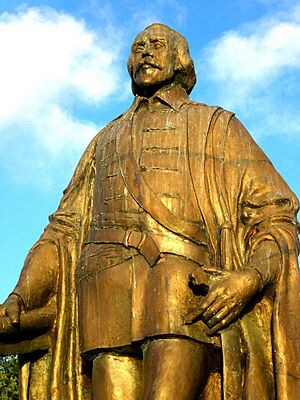Tomé de Sousa facts for kids
Quick facts for kids
Tomé de Sousa
|
|
|---|---|

Statue of Tomé de Sousa at Tomé de Sousa Square, Salvador, Brazil
|
|
| 1st Governor-General of Brazil | |
| In office 1549–1553 |
|
| Monarch | John III |
| Preceded by | Office established |
| Succeeded by | Duarte da Costa |
| Personal details | |
| Born | 1503 Rates, Kingdom of Portugal |
| Died | 1579 (aged 75–76) Kingdom of Portugal |
| Spouse | Maria da Costa |
| Children | Helena de Sousa Francisco de Sousa Garcia de Sousa Iria de Sousa Ana de Sousa |
| Signature | |
| Military service | |
| Allegiance | Portuguese Empire |
Tomé de Sousa (1503–1579) was an important Portuguese nobleman and soldier. He became the very first Governor-General of the Portuguese colony of Brazil. He held this important role from 1549 to 1553.
Sousa was born in Rates, Portugal. He took part in military trips to Africa and fought in battles there. He also commanded a large ship called the Conceição on a journey to Portuguese India.
Contents
Tomé de Sousa: Early Life & Career
Tomé de Sousa came from a noble family. His father was a church leader and a descendant of King Afonso III. Even though he was born outside of marriage, he worked for the royal court from a young age. His cousin, Antônio de Ataíde, helped him get started.
Military Service Before Brazil
Before he became Governor-General of Brazil, Sousa was a soldier. He fought in Morocco and other parts of North Africa. He also traveled for the spice trade in India, which was very important to Portugal.
In 1536, the Portuguese government recognized his hard work. Three years later, he was made a knight for his achievements in the military. He was also the first knight commander of the old Monastery of Rates.
Tomé de Sousa: Leading Brazil
In 1549, Tomé de Sousa sailed to Brazil with six ships. He brought soldiers, a thousand citizens, and missionaries. His main goals were to protect the colony from French pirates and to spread Christianity among the local Indigenous people. He also wanted to make Portugal's power in Brazil much stronger.
Why Portugal Focused on Brazil
Before Sousa arrived, Portugal had not paid much attention to Brazil. They were more focused on the profitable spice trade in India. However, the spice trade started to decline. Also, there were growing threats from Spanish colonies near Brazil's borders. This made Portugal decide to get more involved.
Building the Capital City
Sousa was given the job of bringing the king's authority back to Colonial Brazil. He bought land from Francisco Pereira Coutinho, who was in charge of Bahia. This land became the capital city of Salvador. Salvador was built on the Atlantic coast, between São Paulo and Pernambuco.
The new capital was in a good spot for defense. Sousa himself helped to fortify it. The plan was to bring together the twelve settlements that already existed. Sousa traveled around the areas nearby to promote his ideas of justice and order.
Strengthening Portuguese Rule
Sousa sent officials to other Portuguese areas in Brazil. This was to make sure things were being done correctly and to improve how the colony was managed. He wanted to make Brazil a strong military base. This would protect the Portuguese settlers from Indigenous groups or other outside forces.
He did this by removing hostile Indigenous people to make colonization safer. He brought 1,000 colonists and soldiers with him. This group included four hundred "degredados," who were men sent from Portugal for minor crimes.
Working with Missionaries
Among the colonists were six Jesuits, who were the first in Brazil. Sousa helped them teach Christianity to the Indigenous people. This also helped to strengthen the King's rule over the colonies. Sousa worked closely with Manuel da Nóbrega and the Jesuit missionaries. This allowed him to keep an eye on other territories and Indigenous groups.
Developing the Colony
Sousa also gave land grants to other settlers. This was possible because the territory was now better protected. He was successful in reducing conflicts between the colonists and Indigenous people. He used diplomacy, but also strong punishments when needed.
Besides spreading Christianity, Sousa set up market days. This encouraged trade between settlers and Indigenous people. During his time in office, Sousa made Portuguese territories stronger. He also started new communities with churches and schools.
He brought livestock to Brazil and helped start sugarcane production. He is also known for setting up the first bishopric (a church district led by a bishop) in Brazil with Dom Pero Fernandes Sardinha.
Expanding His Influence
In 1553, Sousa worked beyond his own area of Salvador. He helped make the economy and defenses of São Vicente stronger. He also went on to establish the village of Itanhaém. That same year, Sousa returned home to Portugal. He left Salvador in the care of Duarte da Costa.
Tomé de Sousa: Return to Portugal
In 1552, Sousa suggested that Rio de Janeiro could be a good place for a new settlement. In 1553, he went back to Portugal to work with the King. He became the King's adviser on matters related to Brazil.
Sousa also helped attract more settlers to Brazil. He did this by setting up local governments in the cities, similar to those in Portugal. He also appointed local officials to oversee the different captaincies (regions). He strengthened important areas along the coast to keep the citizens safe.
Descendants
The de Souza family in West Africa believes their ancestor, Francisco Félix de Sousa, was a direct descendant of Tomé de Sousa. Francisco Félix de Sousa arrived in Dahomey after leaving Brazil. He became a powerful slave trader and royal adviser, eventually becoming an African chieftain. He had many children, and their descendants became important people in the region.

